Nature Notes
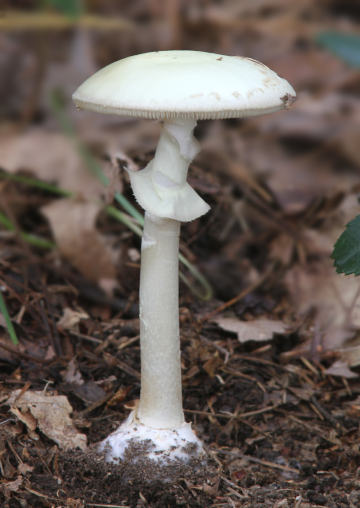
PHOTO COURTESY OF GARRY KESSLER
Destroying angel
October 19, 2022
NATURE NOTES
By Annie Reid
Westborough Community Land Trust
Connecting with wild mushrooms
Wild mushrooms seemed to be popping up everywhere in early September, when lifelong naturalist Joe Choiniere led a Westborough Community Land Trust walk in Wile Forest. Rains had come to the rescue in what had been shaping up to be a dismal fall mushroom season due to the summer’s drought.
How did that happen? Mushrooms consist of an above-ground cap and a stalk. They produce and spread spores for fungi that live underground as vast unseen networks of long, thread-like cells throughout the soil. When it rains, these cells rapidly absorb moisture and can produce mushrooms seemingly, and sometimes actually, overnight. Mushrooms and their underground fungal networks are made largely of chitin, a carbohydrate also found in external skeletons of insects and in crab and lobster shells.
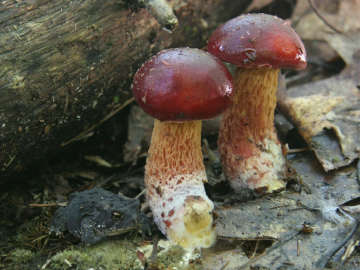
PHOTO COURTESY OF GARRY KESSLER
Frost’s bolete
“Fungi connect the world,” Joe Choiniere emphasized. How? The underground fungal networks grow on and into plant and tree roots and carry out a mutually beneficial exchange. The plant or tree gets phosphorus and additional water from the fungus, which in turn gets some sugar produced by the plant. This beneficial relationship is known as a mycorrhizal (pronounced mike-oh-rise-al) or “fungus-root” relationship. Gardeners may know that some potting soils advertise their mycorrhizal contents.
Joe’s walk focused on mushroom identification and ecology, not on mushroom edibility, which is best left to experts – and to the beetles, insects, slugs, and squirrels that nibble wild mushrooms. (What’s ecology? It’s all the relationships that a living thing has with its environment, including other living things – for example, other fungi, plants, insects and other animals, bacteria, viruses – as well as physical things, such as soil, water, sunlight, weather, climate, etc.)
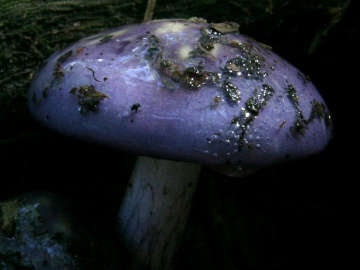
PHOTO COURTESY OF GARRY KESSLER
Viscid violet cort
To start identifying a mushroom, Joe suggested, look under the cap to see whether it has gills or something else, such as pores (which are really the ends of straw-like tubes) or teeth. A mushroom field guide is also helpful (recommendations below).
Joe pointed out more than 20 different mushrooms during the walk and discussed several categories of mushrooms:
Boletes are fleshy mushrooms with pores under the cap. Joe found Frost’s bolete (which can be toxic), Russell’s bolete, red and yellow bolete, and curved stem bolete.
Cortinarius, or “corts,” are a large group of mushrooms with gills. Surprisingly, they’re often purple. They’re mycorrhizal with trees. Walkers got to see several specimens of viscid violet cort, with its slippery, slimy purple cap with yellow spots, often found near oak or beech trees.
Russulas are sometimes called “brittle gills,” because they readily break into little pieces. They come in all the colors of the rainbow and are perhaps our most common gilled mushrooms, Joe said, with about 200 kinds in our area. Red russulas with white stalks are easy to spot but hard to tell apart because there are about 20 similar-looking ones.
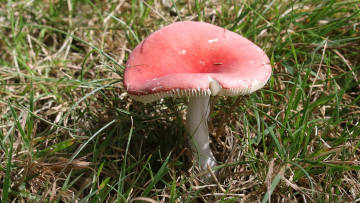
PHOTO COURTESY OF GARRY KESSLER
Red russula
Russulas are mycorrhizal with trees, but Joe described how Indian pipes (a small, all-white, pipe-shaped flowering plant) horn into the beneficial exchange between russulas and oak roots. As a parasite on russulas, Indian pipes fasten their roots onto the underground russula and steal nutrients without making any contribution.
Amanitas include many gilled mushrooms that are toxic to humans. They are okay to touch but not for us to eat or taste. Characteristics include a bulb or cup at the base of the stalk (although the bulb can be buried in the ground), and a ring or skirt near the top of the stalk. (The ring or skirt is a remnant of a thin veil, between the stalk and the edge of the cap, that protected the gills at an earlier stage of growth).
Joe pointed out dinner-plate-sized specimens of “the most poisonous mushroom you can find,” aptly named the destroying angel (Amanita bisporigera/Amanita virosa). This white mushroom contains two deadly toxins that are not affected by cooking or drying. The destroying angel is mycorrhizal and often grows with oak and maple, sometimes in the beds of intermittent streams. It first begins to come up in a stage that resembles an egg, which people unfortunately sometimes mistake for an edible puffball.
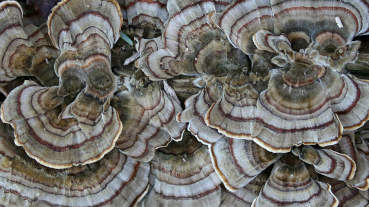
PHOTO COURTESY OF GARRY KESSLER
Turkey tails
Other sightings included:
Turkey tails, a fan-shaped fungus with tiny pores that grows on wood. With multicolored bands, the fans look like fanned-out turkey’s tails, often in time for Thanksgiving. A similar-looking fungus without pores, called false turkey tails, is smooth under the fan.
Night light, clusters of pale tan fans that grow on hardwood logs and sticks, is bioluminescent. The fans give off a faint green glow at night or in a dark closet.
Crowded parchment consists of small reddish-brown petal- or fan-shapes with tan edges, growing on dead branches or stumps.
Lichens, which grow on wood or rocks, are combinations of a fungus and green algae living together and acting as a single organism. The fungus provides a shelter for the algae, which provide food (sugars from photosynthesis) for the fungus. About 5 or 6 fungi in our area form lichens. Instead of algae, sometimes a lichen contains cyanobacteria (a kind of bacteria that can perform photosynthesis).
Joe recommended three field guides: Fascinating Fungi of New England by Lawrence Millman; Mushrooms of the Northeastern United States and Eastern Canada by Timothy Baroni; and The National Audubon Society Field Guide to North American Mushrooms. He noted that genetic research in recent years has led to name and classification changes in fungi, as well as in plants and animals.
Many thanks to Joe for connecting us with wild mushrooms in the woods.
Date index
Month (October)
Common name index
Scientific name index
Category index